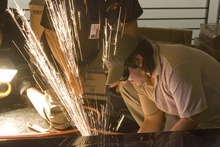This is an archived article that was published on sltrib.com in 2010, and information in the article may be outdated. It is provided only for personal research purposes and may not be reprinted.
No magic potion was necessary to get Harry Potter into the Clark Planetarium — just a theater chain in need of a venue, and a county facility looking to attract more customers.
"We each had what the other needed," said Seth Jarvis, director of the Salt Lake County-owned planetarium.
The Clark Planetarium will reopen its large-format IMAX theater to the public on Friday, Nov. 19 with a new screen, new seats and a state-of-the-art 3-D digital projection system replacing the 70mm film projectors that have illuminated movies there since its opening in April 2003.
The planetarium also has a new business partner — the Larry H. Miller Megaplex Theatres chain — and a new programming plan to add commercial blockbusters to a schedule previously reserved for educational documentaries. First to be screened at the renovated ATK IMAX Theatre is "Harry Potter and the Deathly Hallows, Part 1," with the 3-D computer-game blockbuster "Tron Legacy" coming on Dec. 17.
Megaplex officials proposed the partnership to give the theater chain an IMAX screen near their 12-screen theater at The Gateway shopping center. "It gives us another screen downtown," said Blake Andersen, senior vice president and general manager of Megaplex Theatres. The chain has IMAX screens at its theaters at Jordan Commons in Sandy and at The District in South Jordan.
Jarvis said the planetarium's IMAX shows, though popular during the daytime with field trips and student groups, weren't packing them in at night. "At 8 p.m., you're not wanting to be educated — you want to have a good time," he said.
The planetarium will continue to screen educational films weekdays until 4 p.m. Then the screen will give over to commercial films — though the screen will go wall-to-wall with blockbuster fare for the openings of big titles, such as "Harry Potter" or "Tron Legacy."
Bringing Hollywood films into the ATK IMAX Theatre will earn the planetarium an estimated $140,000 in 2011. "That's the difference between having an exhibits program and not," Jarvis said.
The planetarium had been saving up its money to upgrade the theater to digital presentation, he said. The move was inevitable, he said, because movie distributors have found making digital copies "infinitely less expensive" than striking 70mm film prints.
Installing the new screen, updated sound system, twin projectors (two are needed to show 3-D images), new seats and an improved concession stand cost $575,000, Jarvis said.
The deal with Megaplex will allow the planetarium to keep 15 percent of the box-office gross for Hollywood films, with the rest going back to the theater chain (with much of that going up the line to the studios). The planetarium keeps what it makes on concessions, and the gift shop now stocks Hogwarts scarves and other trinkets.
Jarvis also hopes for a bump in awareness of the planetarium's educational mission. After all, he noted, the exit to the theater takes customers right through the planetarium's solar-system exhibit.





